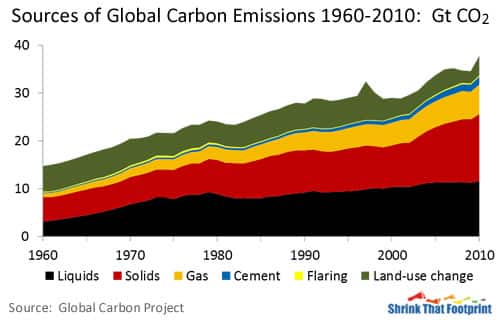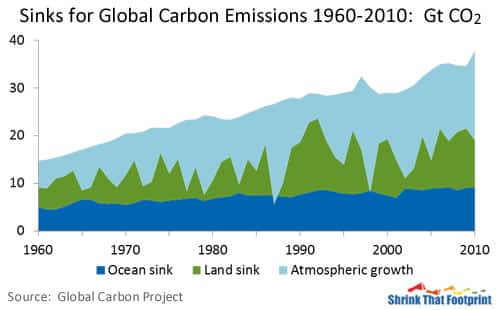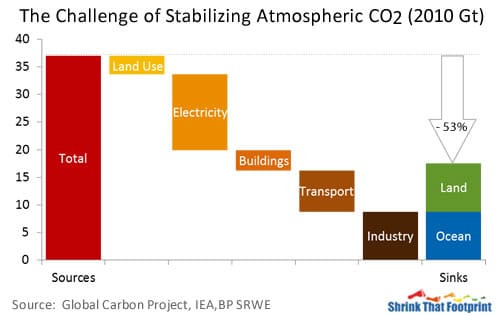Natural Gas As A Bridge Fuel
There has been much talk of natural gas as a “bridge” fuel lately, particularly due to its role in cutting US carbon emissions. Natural gas is enormously popular. It’s used as a fuel at the consumer point-of-use. Gas vs electric appliances are decisions commonly weighed by the end users. Let’s work out what that means in terms of the rate of carbon increase.
From an economic or energy security point of view this might make some sense, but in terms of climate change natural gas is a half measure that risks dangerous procrastination.
If all the coal fired power stations in the world switched to natural gas tomorrow we wouldn’t go close to stabilizing atmospheric carbon dioxide concentrations.
Some simple carbon maths shows why we need to be more ambitious.
Carbon Emission Sources – Why Carbon Is Increasing In The Atmosphere
Fossil fuels have done wonders for economic development ever since the start of the industrial revolution. But if we want to keep on developing without toasting the planet we need to change how we get our energy.
For me, the easiest way to understand our carbon dioxide problem is to think of it in terms of ‘sources’ and ‘sinks’.
The main sources of man made carbon emissions are oil, coal, natural gas and land use change emissions. Whilst the main sinks for carbon emissions are the ocean, the land and the atmosphere.
In the last 50 years the amount of carbon dioxide mankind has emitted has grown dramatically, due to rising fossil fuel emissions.

Man made carbon emissions have grown by 150% since 1960.
The majority of this growth has come from oil, coal and natural gas with a smaller contribution from cement production and gas flaring. Land-use change emissions are down over the last decade because the net flux between deforestation and reforestation is slowly improving.
Carbon Emission Sinks – Where Carbon Is Being Removed From The Atmosphere
Once carbon dioxide goes into the atmosphere it stays there for a long time. About 33% is still there after 100 years, and 20% is still in the atmosphere after 1000 years.
But when we think about where our emissions go it is simpler to look at the net change that occurs to the sinks each year. In this way global carbon emissions are balanced by the annual absorption of the ocean, land and atmospheric sinks.
The following chart shows where our human carbon emissions have gone over the last 50 years.

The Current Rate Of Growth Of Carbon Sources Outstrips The Sinks
At present there is no single technology or policy capable of dealing with the carbon problem by itself. We need to work with everything that we have as well as invest in creating new low carbon tools.
An incomplete menu of our options looks something like this:
The oceans have absorbed 29% of man made carbon emissions since 1960. Land sinks including vegetation, soils and humus have absorbed 27%. Whilst 44% of carbon emissions have resulted in the growth of atmospheric carbon dioxide concentrations.
The light blue section of this chart is equivalent to the share of annual carbon emissions that ends up in the atmosphere. For each 7.8 Gt CO2 that remains in the atmosphere the atmospheric concentration of carbon dioxide rises by 1 ppm (parts per million). Between 2000 and 2009 we added an average of 15 Gt CO2 to the atmosphere each year resulting in atmospheric carbon dioxide concentrations rising by an average of 2 ppm each year. The growth rate last decade was higher than in any earlier decade.
Between 1960 and 2010 growing carbon emissions have caused atmospheric concentrations of carbon dioxide to grow from 317 ppm to 389 ppm. If it wasn’t for the ocean and land sinks absorbing more carbon dioxide with both rising concentrations and rising emission rates we would already be pushing 500 ppm.
To stop the growth in the atmospheric carbon dioxide concentrations human carbon emissions would need to be balanced by the sink capacity growth in the land and oceans. To slow the acidification of the oceans we would need to do much more.
The Scale Of Our Problem Is Global On The Order Of Gigatons
Stabilizing atmospheric concentrations of carbon dioxide is the central challenge of climate change.
We also need action on other positive forcing agents like methane, nitrous oxide, ozone and black carbon, as well as further study of aerosol and cloud management, but without tackling carbon dioxide we cannot properly address climate change.
Although the most common way to highlight the scale of this challenge is as a carbon budget between now and 2050, I find it much easier to understand by just thinking about one year. That way I’m not thinking about 2050, I’m thinking about what needs to happen today.
I’ll use 2010 as an example.

Based on global sources of carbon dioxide in 2010 and the average sink absorption over the last decade we would need to cut global emissions in half to stabilize atmospheric carbon dioxide concentrations. But in fact sinks absorption is also a function of emission rates, so this immediate cut in half would need to be quickly followed by more rapid emissions reductions to maintain stable concentrations. If technically possible we could also stabilize concentrations by doubling the rate at which carbon dioxide is absorbed by the oceans, land or possibly by some type of technology. But that technology is not really in existence.
In terms of cutting emissions a 53% reduction in 2010 emissions is equal to almost 20 Gt. This equivalent to all land-use emissions, all electricity generation emissions and most building emissions put together.
Switching The World’s Coal To Natural Gas Leaves 4 Gigatons Of Emissions Per Year
For some perspective, global emissions from coal fired electricity generation were about 9 Gt CO2 in 2010. If every coal fired power station in the world switched to natural gas tomorrow it would cut 5 Gt of CO2 from our emissions at most. That would take us from 40 Gt of emissions down to 36 Gt.
Impressive? Yes, but it is just a quarter of what is needed to stabilize atmospheric CO2 in the very short term, and nothing like what is needed in the long run.
In fact given the expect rise in power generation global these cuts would be all but cancelled by demand growth. Moreover, if you also consider methane and particulates in your calculations the ‘benefits’ of switching to gas evaporate even further. In reality we need to be cutting carbon at 4% per annum while growing energy supply.
But We Need To Cut To 20 Gigatons To Stabilize Carbon
If the world is remotely serious about stabilizing atmospheric carbon concentrations while meeting the growing demand for energy in developing economies there is no time for fossil fuel “bridges”, unless they include carbon capture and storage. If no one can make carbon capture and storage work then we need to gradually marginalize fossil fuel use to producing things like steel, cement, plastics and fertilizer and moving them in ships, trucks and planes.
On Top We Face Growing Energy Needs
Most forecasts expect global energy demand to grow by 50-100% between now and 2050, as poorer nations develop and the global population grows. At the same time research highlights the risks of land and ocean sinks becoming less efficient over time. In the worst case scenarios sinks could actually become net sources of emissions in the future due to feedbacks like forest fire, drying peatlands, melting permafrost and out-gassing from the oceans.
To have any chance of doubling energy use, cutting carbon emissions and improving natural sinks we need every low carbon policy, technology and action available.
More Needs To Be Done Than Using Natural Gas As A Bridge Fuel
At present there is no single technology or policy capable of dealing with the carbon problem by itself. We need to work with everything that we have as well as invest in creating new low carbon tools.
An incomplete menu of our options looks something like this:
- Carbon pricing – carbon taxes, cap and trade, subsidies
- Efficiency standards – buildings, vehicles, appliances and gadgets
- Low carbon power – wind, solar, nuclear, hydro, biomass, geothermal
- Carbon capture and storage – new build, retrofit, air capture
- Innovation – power storage, biofuels, materials, vehicles . .
- Planning – low carbon cities, architecture and design
- Sinks – deforestation, afforestation, biochar, conservation tillage
Rather than competing many of these ideas actually reinforce one another.
A stable carbon price, for example, would improve the incentives for all manner of technology deployment and innovation. Efficiency standards can achieve mitigation in sectors that aren’t price sensitive. And the improvement of land sinks could provide enormous mitigation at relatively low cost while we build new energy infrastructure.
And that is just carbon. We also need a similar urgency to mitigate black carbon, methane, nitrous oxide and ozone as well as to study if the potential benefits of using the oceans, aerosols or clouds to cool the planet in the future will outweigh the risks.
Whatever the best mix of solutions is one thing is clear, the only fossil fuel ‘bridge’ we can afford to build is carbon capture and storage. Natural gas might be preferable to coal and oil, and be a natural back-up to wind and solar in the power sector, but it just isn’t good enough given the global carbon constraints.
Given that 87% of global energy supply in 2010 came from coal, oil and natural gas that may sound naive, but the alternative is untenable. We simply can’t afford to build ‘bridges’ from coal, to tar sands, to shale gas, to methane clathrates.
Our carbon problem requires far greater ambition.
Lindsay Wilson
I founded Shrink That Footprint in November 2012, after a long period of research. For many years I have calculated, studied and worked with carbon footprints, and Shrink That Footprint is that interest come to life.
I have an Economics degree from UCL, have previously worked as an energy efficiency analyst at BNEF and continue to work as a strategy consultant at Maneas. I have consulted to numerous clients in energy and finance, as well as the World Economic Forum.
When I’m not crunching carbon footprints you’ll often find me helping my two year old son tend to the tomatoes, salad and peppers growing in our upcycled greenhouse.
